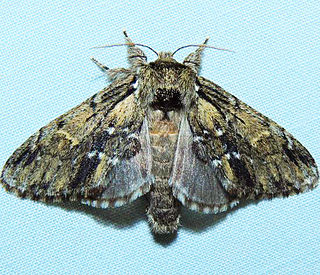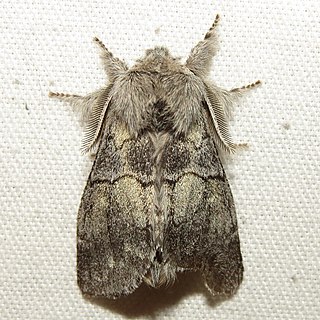Pseudhapigia is a monotypic moth genus of the family Notodontidae. Its only species, Pseudhapigia brunnea, is found in North America including its type location in Guadalajara, Mexico. The genus and species were first described by William Schaus in 1901.
Nemeris speciosa is a species of geometrid moth in the family Geometridae. It is found in North America.
Nemeris percne is a species of geometrid moth in the family Geometridae. It is found in North America.
Pseudobryomima distans is a species of cutworm or dart moth in the family Noctuidae first described by William Barnes and James Halliday McDunnough in 1912. It is found in North America.
Sympistis deceptiva is a species of moth in the family Noctuidae. It was first described by William Barnes and Arthur Ward Lindsey in 1922 and it is found in North America.

Nychioptera accola is a species of moth in the family Erebidae first described by John G. Franclemont in 1966. It is found in North America.
Piruna polingii, the four-spotted skipperling, is a species of intermediate skipper in the family of butterflies known as Hesperiidae. It was first described by William Barnes in 1900 and it is found in Central and North America.
Amolita fratercula is a species of moth in the family Erebidae first described by William Barnes and James Halliday McDunnough in 1912. It is found in North America.
Hyparpax perophoroides, the red-lined yellow prominent or lilac moth, is a species of moth in the family Notodontidae. It was first described by Strecker in 1876 and it is found in North America.
Zale bethunei, or Bethune's zale, is a species of moth in the family Erebidae first described by Smith in 1908. It is found in North America.
Hemileuca juno, the Juno buck moth, is an insect in the family Saturniidae. The species was first described by Alpheus Spring Packard in 1872. It is found in Central and North America.

Rifargia lineata is a species of moth in the family Notodontidae. It was first described by Druce in 1887 and it is found in North America.

Nemoria pulcherrima is a species of emerald moth in the family Geometridae first described by William Barnes and James Halliday McDunnough in 1916. It is found in North America.
Euxoa xasta is a species of cutworm or dart moth in the family Noctuidae first described by William Barnes and James Halliday McDunnough in 1910. It is found in North America.

Hyperaeschra georgica, the Georgian prominent, is a species of moth in the family Notodontidae. It was first described by Gottlieb August Wilhelm Herrich-Schäffer in 1855 and it is found in North America and parts of Australia.
Stylopoda modestella is a species of moth in the family Noctuidae. It was first described by William Barnes and James Halliday McDunnough in 1918 and it is found in North America.

Gluphisia lintneri, the Lintner's gluphisia moth or Lintner's pebble, is a species of moth in the family Notodontidae. It was first described by Augustus Radcliffe Grote in 1877 and it is found in North America.
Tripudia damozela is a species of moth in the family Noctuidae. It was first described by Harrison Gray Dyar Jr. in 1914 and it is found in Central and North America.
Philtraea paucimacula is a species of moth in the family Geometridae first described by William Barnes and James Halliday McDunnough in 1918. It is found in North America.
Lacinipolia buscki is a species of cutworm or dart moth in the family Noctuidae first described by William Barnes and Foster Hendrickson Benjamin in 1927. It is found in Australia and North America.




